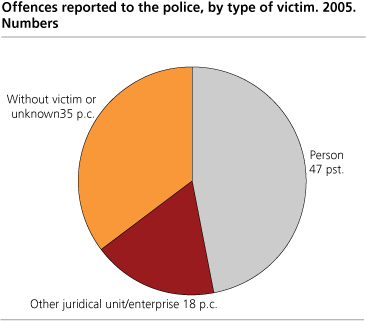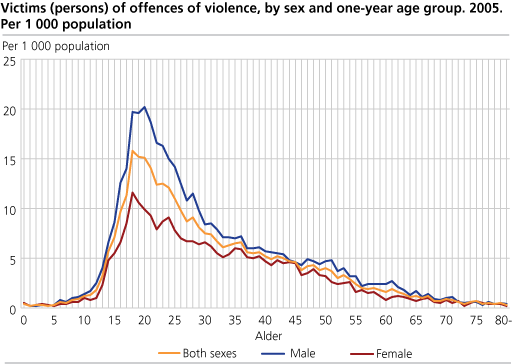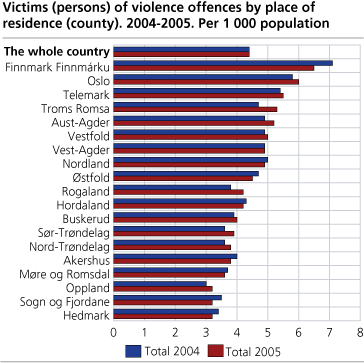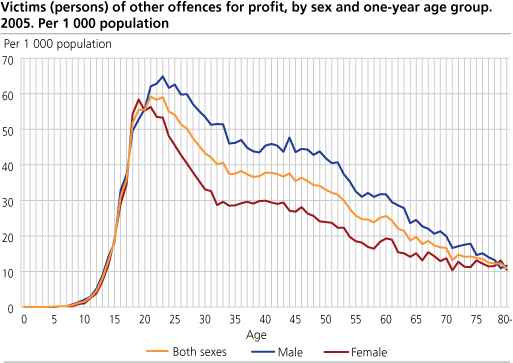Content
Published:
This is an archived release.
20 600 victims of violence - but hardly any children
Police reports show that almost 171 000 persons were exposed to 186 000 offences in 2005. Small children are considerably over-represented among victims of sexual crimes, but to a very small extent registered as victims of violence or other types of offences.
Of the 394 000 offences reported to the police in 2005, 47 per cent is registered with one victim (person), 18 per cent is committed against an enterprise or other juridical units, and 35 per cent is without a registered victim. Narcotic- and traffic offences are examples of offences which not necessarily have caused a direct experience of victimization, and in these groups of offence we find 90 500 of those without registered victim. In 2005, there was about the same number of reported offences without a victim as in 2004. 61 per cent of all crimes reported to the police are registered with a person as victim, contrary to only 14 per cent of all misdemeanours reported to the police.
During 2005, 3.7 per cent of all Norwegian residents were registered as victim to one or more offences reported to the police. Young adults are in total most exposed, and 59 per cent of the registered victims are men. Theft is clearly the most common offence, with a total of 125 000 victims (persons).
Decrease in theft against persons
In 2005, 3.2 per cent less offences were reported to the police than the previous year (see Offences reported to the police ), and the statistics on victims shows that this mainly is connected to a decrease in number of reported offences committed against private individuals. Compared to offences reported to the police the previous year, 5.5 per cent less victims (persons) were exposed to 5.9 per cent less offences. This is primarily due to a decrease in persons’ exposure to theft and other offences for profit, where there were 6.8 per cent less victims of 7.2 per cent less offences. Out of principal offence there were 6 000 victims (persons) of traffic offences and 9 000 victims (persons) of damage to property, respectively 4 and 3 per cent less than in 2004.
but not less victims of violence
From offences reported to the police it follows that 20 600 persons were exposed to 21 500 cases of violent crime - which in total is somewhat more than the year before. From the principal offence, there were 5 per cent more victims of wounding or inflicting bodily harm and almost 3 per cent more victims of assault. The number of victims of threats was on the contrary 2 per cent less in 2005 than in 2004.
Grievousness in violence increases by age, and differ between sexes
Out of reports to the police, the risk of being exposed to crime of violence is highest during the first years after obtained age of majority. This is the case for both men and women, but the risk of violence is considerably higher for young men - and in the age group 20-22 it is more than twice as high as for women. Exposures to violent offences are thereafter systematically reduced by increasingly age (see figure). More than half of all victims of violence and threats are under 30 years old, and three out of four is under 40 years. The share of victims under 30 years is somewhat lower among women than among men (respectively 48 and 55 per cent).
It also seems that victims are older the more serious physical violence they are exposed to. From principal offence, 71 per cent of all victims of assault, 78 per cent of wounding or inflicting bodily harm and 87 per cent of inflicting grievous bodily harm over 20 years. There are also larger differences between sexes in exposure to wounding or inflicting bodily harm (81 per cent men) than the less serious assaults (61 per cent men) and threats (55 per cent men).
Highest risk of violence for Finnmark residents
From the victim's place of residence and the population, Finnmark and Oslo are the two counties where people have the highest risk of being exposed to offences of violence. This is true for both men and women. Compared to the previous year, however, the share of victims exposed to violent crimes living in Finnmark decreased by more than 8 per cent. According to population, the share of victims of violence increased by nearly 13 per cent in Troms and 11 per cent in Rogaland (see figure).
The reports to the police also show some difference in the distribution of male and female victims of violence and threats in the different counties: Of victims living in Østfold, 46 per cent are women, whilst the corresponding share in Sogn og Fjordane is 34 per cent.
Nearly half of all the youngest children are exposed to sexual offences
Children relatively seldom register as victims in criminal cases. This is partly due to children not being direct owners of things - and with that, seldom counts as victims of theft and crimes inflicting damage to property. Altogether, 1 250 children under 10 years of age were reported to the police as victims of one or more offences in 2005. 44 per cent of these are exposed to sexual crimes. Other types of encroachments against small children are on the contrary not reported to the police as often. During 2005 the police registered only 273 victims of violence and threats in the age group 0-9 years. In other words, the police get reports about more than twice as many young children as victims of sexual crime than young children as victims of violent crimes.
Children and youth are considerably over-represented among all victims of sexual crimes: More than half of all new victims of sexual offences reported to the police, are children under the age of 16 years. Girls and women represent 88 per cent of all victims of sexual crimes.
Inhabitants of Oslo most victimized
Altogether 5.8 percent of Oslo residents - compared to 3.7 percent in the whole country - registered as victim of one or more offences in 2005. Most exposed is the age group 20-29 years, and 9 per cent of all inhabitants of Oslo in this age group were registered as a victim of an offence in 2005. Every fifth victim of theft lives in Oslo, even if they only make 11.5 percent of the Norwegian population.
During 2005 more than 74 000 men, and almost 51 000 women, were registered as victimized to at least one offence for profit. However, in the ages up to 20 included, the same number of women and men are registered as victims of offences for profit (see figure).
Almost 70 000 offences against enterprises
Enterprises reported in 2005 to have been victimized to nearly 50 000 offences for profit, 3,2 percent less than the previous year. In addition, enterprises reported to have been victimized to 9 000 offences of damage to property, 14 per cent more than in 2004. Enterprises and other juridical units totally reported to have been victimized to 69 500 offences, which is 1.3 percent less than in 2004.
|
Statistics on victims of offences, reported to the police
The statistics is based on information from the police criminal record system (BL/STRASAK/PAL) and embodies all with part as victim in all offences registered by the police in 2005. More on production, definitions and sources of errors in About the statistics . |
Tables:
- Table 1 Offences reported to the police, by type of victim and group of offence. 2005. Absolute figures
- Table 2 Victims (persons) by number of offences, sex and age. 2005. Absolute figures and per cent
- Table 3 Victims (persons) by sex, age and place of residence (county). 2005. Absolute figures and per 1 000 population
- Table 4 Victims (persons) by group of principal offence, sex and age. 2005. Absolute figures and per 1 000 population
- Table 5 Victims (persons) by group of principal offence and one-year age group. 2005. Absolute figures
- Table 6 Victims (persons) by group of principal offence and one-year age group. 2005. Per 1 000 population
- Table 7 Victims (persons) by group of principal offence and place of residence (county). 2005. Numbers and per 1 000 population
- Table 8 Victims (persons) by sex, age and type of principal offence. 2005. Absolute figures
- Table 9 Victims (persons) of offences for profit, by sex and one-year age group. 2005. Absolute figures and per 1 000 population
- Table 10 Victims (persons) of offences for profit, by sex, age and place of residence (county). 2005. Absolute figures and per 1 000 population
- Table 11 Victims (persons) of offences for profit, by number of offences for profit, sex and age. 2005. Absolute figures and per cent
- Table 12 Victims (persons) of offences of violence, by sex and one-year age group. 2005. Absolute figures and per 1 000 population
- Table 13 Victims (persons) of offences of violence, by sex, age and place of residence (county). 2005. Absolute figures and per 1 000 population
- Table 14 Victims (persons) of offences of violence, by number of offences of violence, sex and age. 2005. Absolute figures and per cent
The statistics is now published as Offences and victims reported to the police.
Contact
-
Statistics Norway's Information Centre
E-mail: informasjon@ssb.no
tel.: (+47) 21 09 46 42




